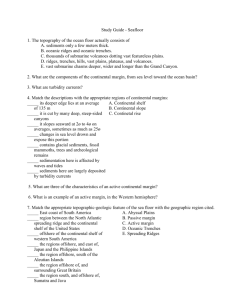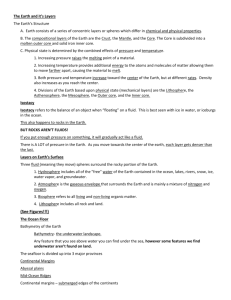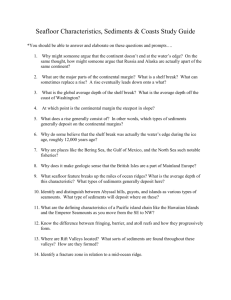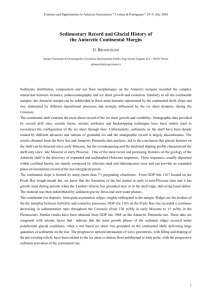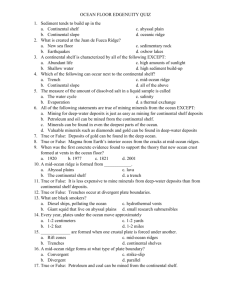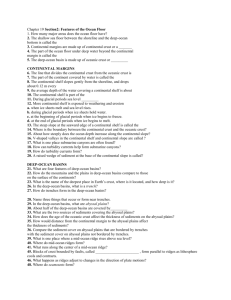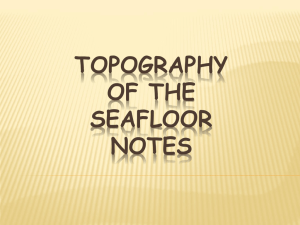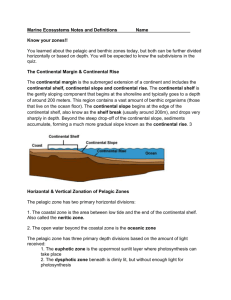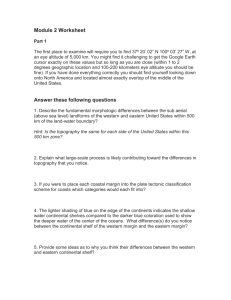Ocean Basin and Sediments
advertisement
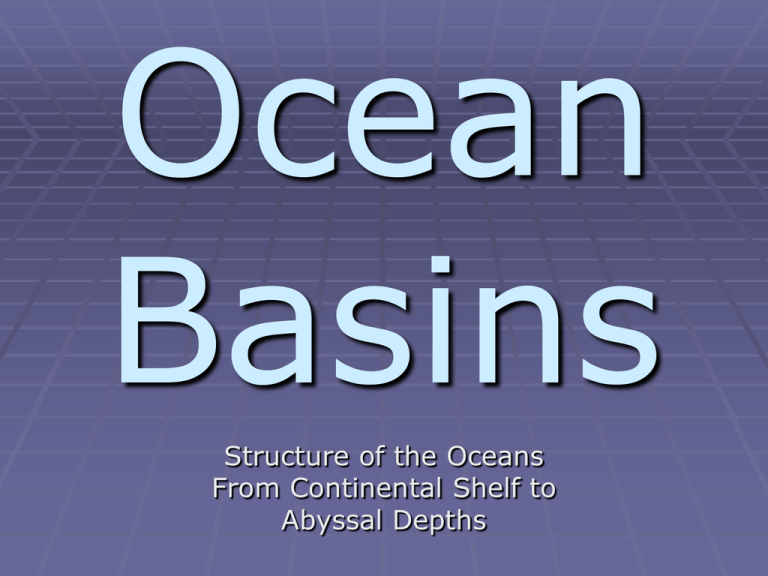
Ocean Basins Structure of the Oceans From Continental Shelf to Abyssal Depths Measuring Depth 85 BC Posidonius ~2km Hemp line and greased lead weight tension Fathoms (6 feet) Piano wire and cannonball w/ winch By 1895 only 7000 measurements to 2000m and 550 to >9000m Echo sounder (depth recorder) 1920s Meteor- mid-Atlantic ridge 1950s detailed mapping of ridges and trenches Heezen and Tharp 2 Echo Sounder Bathymetry LADS (shallow water) Laser airborne depth sounder Fixed winged aircraft/ GPS Operating depth of 0.5-70m Gravity measurements Changes in sea surface elevation Seamounts +5m and ridges +10m Trenches -25-30m Satellite altimetry Side-scan sonar 4 Marine Gravity Anomalies by Satellite Altimetry Bathymetry of the Sea Floor Continental Margin- Passive and Active Continental shelf (Flat- 10-1500km, 65km; 20500m deep) Continental shelf break Continental slope (Steep) Submarine canyons Turbidity currents and turbidites Continental rise Ocean Floor Ridges, Rises and Trenches 8 Slope Shelf Break Rise MidAtlantic ridge Computer Drawn Topographic Profiles Continental Shelves Formation of Shelves by trapping of land derived sediments Turbidity Currents- 90km/hr, 300kg of sed in suspension Submarine Canyon D C A Ancient Turbidite Sequence Bouma Sequence Top- (E)Pelagic Seds (D)Parallel Laminated Sands (C)Rippled, wavy or convoluted laminae (B)Plane Parallel Laminae Bottom-(A)Massive Graded Bathymetry of the Sea Floor Ocean Floor Deep seafloor (4000-6000m cover 30% of Earth’s surface) Abyssal Plain (Flat) Pelagic sediments and turbidites Abyssal hills and seamounts & Guyots <1000m high; steep sided volcanoes Found on 50% Atlantic and 80% Pacific seafloor Some become atolls Ridges, Rises and Trenches 65,000km mountain range Challenger Deep (Mariana Trench 11,020m) 17 Major Ocean Basins Sediments Continental margins and ocean basins receive continuous supply Organic plankton Terrigenous (Land) Rivers, beaches Atmospheric wind Space tektites (meteorites) 24 Continental Margin Thick Sequence of sediments (1000’s m) Passive margin Gravels, sands, muds Rates of deposition vary 8m/yr in estuaries 5m/1000yr quiet bays Shelf and slope 10-40cm/1000yrs Carbonates Salts Potential for resources Oil Gas Methane Hydrates 26 Sand and Gravel 1.2 billion tons/yr Reserves of 800 billion tons US 450 billion tons UK & Japan take 20% from seafloor Other materials found within such as Fe, U, Pt, Au & Diamond The Tin Belt of SE Asia Carbonate sands 27 Oil and Gas account for 95% of material exploited from the sea 24.8% of oil and 20.7% gas in US came from offshore production (1997) Gas Hydrates and other Gases • Geopressurized zones • Methane Hydrates, crystalline solids of gas and water abundant in arctic regions and marine sediments • 1 ft3 releases 160 ft3 gas • Offshore east coast area of potentially 1300 trillion ft3 gas • Reserves 4x1020 ft3 Atmosphere-Wind Winds from deserts transfer terrigenous sediment 1000’s kms into ocean basin Annual supply to oceans 100x106 metric tons Sahara-Caribbean connection Reefs Soils 32 Sorting Poorly Well Biogenous Sediment Planktonic- Siliceous and Carbonate Oozes Phytoplankton Diatoms (silica) Coccolithosphorids (carbonate) Zooplankton Radiolarians (silica) Foraminefera (carbonate) Lysocline (dissolution) CCD (carbonate compensation depth) <20% preservation CO3 ~4500m Atlantic (5000m) Pacific (4200-4500m); Equatorial Pacific (5000m) 44 Diatoms Coccolithosphorids Radiolarians Foraminifera Hydrogenous Sediment Slow formation in water column Chemically precipitated Carbonates (ooids, calcareous muds) Phosphorites (fertilizers) Continental shelf and slope Reserve ~ 50 billion tons Nodules or crusts Due to high nutrients-upwelling Salts (Mediterranean) Manganese nodules Concentric layering High in Fe, Cu also 1-10cm diameter Hydrothermal vents (smokers)-ores (sulfides) 48 When wind blow offshore, they push the warm surface waters away from the coastline This creates a region of low pressure and may result in upwelling of deep water to replace surface water. The deep waters contain dissolved nutrients which can support abundant life at the surface Many fishing grounds exist in these areas, notably the west coast of N. & S. America and w coast of Africa Upwelling 49 Laws and Treaties 200-mile EEZ Law of the Sea (1982) All wealth is shared by humanity Regulated by UN Profits shared US did not sign treaty Provisional Understanding Regarding Deep Seabed Matters (1984)- Western countries (US, UK, Germany, Japan…) 4 consortia awarded exploration licenses 55 Sediments as Records Paleoceanography Isotopic studies Oxygen isotope ratios in skeletal material to infer past climate (18O:16O) Dependant on ratio in seawater During glaciations is 16O removed, so 18O:16O ratio increases in seawater Marine plankton distribution Circulation models 56
